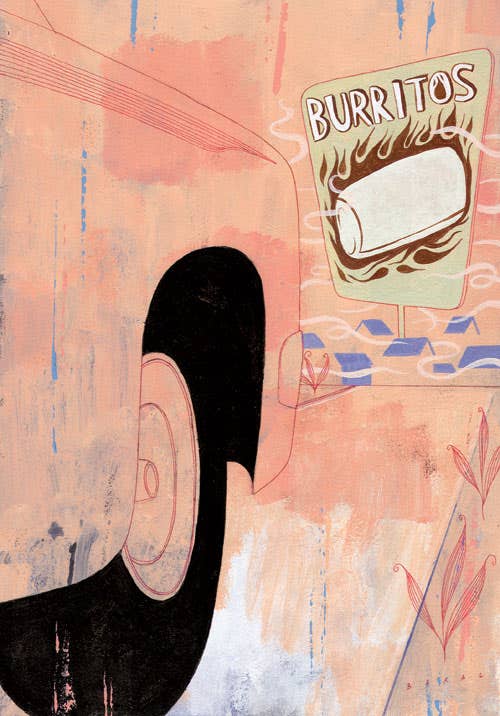
The drive from Anaheim, California, to Jerez, Zacatecas, seemed to me like a long, unnecessary detour. But nearly every Christmas break during my childhood in the 1980s, my parents would load us up in our Ford Ranger and make the trek to their home city. The truck would rumble eastbound on I-10 until we hit El Paso, then make a dramatic turn south through Juarez, and into burrito heaven.
Upon entering Juarez, we'd join the traffic on what's now called Carretera Federal 45, and reach the town of Villa Ahumada—"smoked village" being an appropriate name, considering all the cooking that goes on there. Here, roadside stalls, sit-down restaurants, and street vendors sell burritos of every stripe—vegetarian (rajas con queso, chiles with cheese); spiced ground beef called picadillo; even hot dogs stewed with salsa, hilariously known as burritos de weenie—all rolled into a flour wrapper folded in such a way so that the ends are not tucked in, better to portion out the bites with filling and those of pure tortilla.
It was a great pit stop for the family, but especially fun for my parents. Whereas their Americanized children had grown up on burritos, the ones in Ahumada were the first my folks actually enjoyed. The burrito to them was as alien as a Korean taco; being from Zacatecas, where corn tortillas are the norm, they hadn't even tasted the flour variety until migrating to California in the 1960s. The American obsession with the food bewildered them—the ones we ate in the States were as Mexican as Doritos. But in Villa Ahumada, my parents were happy to feed on burritos because, well, that's what everybody ate. To them, Ahumada was the place where America became Mexico, and Mexico became America; the burrito was the food that embodied that in-between place.
If the taco is the ambassador of Mexican food in the United States, then the burrito is the eternal misfit. All sorts of gastronomic sins get committed in its name: It's stuffed with french fries in San Diego and deli pastrami in Los Angeles; wrapped around a hamburger and smothered with chili in Denver. It's the most Americanized of Mexican dishes, one so pocho (slang for a Mexican who has gone gringo) that many gourmands incorrectly point out that the burrito is in fact an American creation.
But in the borderlands of Mexico, the burrito has reigned for nearly a century as a simple, austere beauty reflective of its sparse environment. It's here that the meal reaches its apotheosis, not as a tortilla wrapped around an avalanche of mush, but as a dish in which each part complements the others: an expertly toasted flour tortilla, with just enough filling so that it can be tightly wrapped to the girth of a child's wrist. The ideal iteration is more graceful than gargantuan.
Even so, no one knows who invented the burrito. Historians have traced the term as far back as 1895, to central Mexico, where then as now it signified a tortilla rolled around ingredients. But today, the burrito exists in earnest only in northern Mexico. This is the homeland of the flour tortilla, and from this universal vessel, the regions of northern Mexico create burritos with their own homegrown ingredients. In Baja California, burritos feature fresh fish from the coast; in the Sonoran plains, carne seca (sun-dried beef) reigns; in Chihuahua, queso menonita (a pale yellow cheese made by Mennonite colonies), goes into nearly all of them.
But the ultimate burrito trail remains Carretera 45. I haven't gone down that road in decades, partly because my parents can now afford to fly to Zacatecas, but really because the narco wars have soured that trek for us. But I'm an optimist, and plan to take my parents back to Ahumada one day, for a reminder of the time when those burritos were the first sign that we were on our way home.
Gustavo Arellano is the author of Taco USA: How Mexican Food Conquered America (Scribner, 2012)
Keep Reading
Continue to Next Story










